| |

| Author |
Topic Options
|

 Posts:
Posts: 19986
 Posted: Posted: Wed Mar 04, 2009 10:03 pm
Vancouver Millionaires
1914-15
As per an informal agreement between the NHA and PCHA, the regular season champions of both leagues would meet for an opportunity to vie for the Stanley Cup. After eliminating the Montreal Canadiens in a two game total goals series, the Ottawa Senators of the NHA were primed to face the Vancouver Millionaires, champions of the PCHA. The championship would be waged in a best of five series. Vancouver came at the Senators hard, sweeping the series in three. The Millionaires scored 26 goals in the process while limiting the Senators to just eight. Fred "Cyclone" Taylor paced Vancouver with six goals. The Millionaires took the Stanley Cup home, the farthest west it had been to that date. 
|

 Posts:
Posts: 9914
 Posted: Posted: Thu Mar 05, 2009 8:49 am
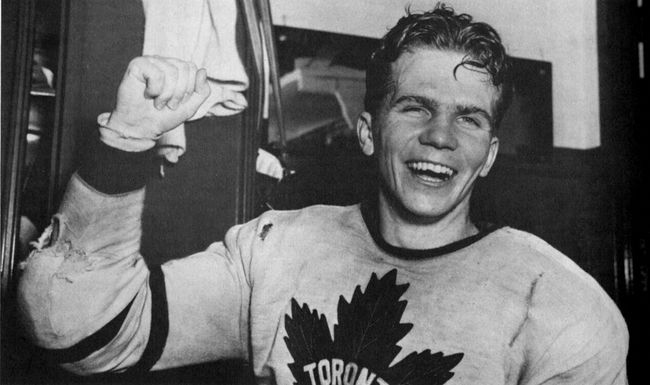 William "Bashin' Bill" Barilko (born March 25, 1927 in Timmins, Ontario – died August 26, 1951 near Cochrane, Ontario) was a Canadian ice hockey player of Ukrainian descent who played his entire National Hockey League career for the Toronto Maple Leafs. In February 1947, Barilko was called up to the Maple Leafs from the PCHL's Hollywood Wolves and played for the big club until his death. His sweater number was 21 when he first donned the blue and white during the 1946-47 and 1947-48 seasons. He was promoted to number 19 for the 1948-49 and 1949-50 seasons. The number 5 (which was retired by the Leafs) was only worn by Barilko for one season, 1950-51. During that span of five seasons, Barilko and the Toronto Maple Leafs were Stanley Cup champions on four occasions 1947, 1948, 1949, 1951. Barilko scored the overtime goal against the Montreal Canadiens' Gerry McNeil in Game 5 of the Stanley Cup final on April 21, 1951, to clinch the Cup for the Maple Leafs. Four months later, on August 26, 1951, he joined his dentist Henry Hudson on a flight aboard Hudson's Fairchild 24 floatplane to Seal River, Quebec, for a fishing trip. On the return trip, the single-engine plane disappeared and its passengers remained missing. On June 7, 1962, helicopter pilot Ron Boyd discovered the wreckage of the plane about 100 kilometres (60 miles) north of Cochrane, Ontario (about 35 miles off course). The cause of the crash was deemed to have been a combination of pilot inexperience and poor weather.Notably, the Maple Leafs won the Stanley Cup that year, after not winning it at all during the eleven years that he was missing. The Tragically Hip's song "Fifty Mission Cap", from their 1992 album Fully Completely, features Barilko's tragic story and the lack of another Leafs championship " 'til 1962, the year he was discovered."
|

 Posts:
Posts: 9914
 Posted: Posted: Mon Mar 09, 2009 7:36 pm
Jack "Doc" Gibson 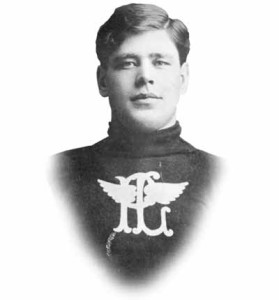 The International Professional Hockey League (IPHL) was the first fully professional ice hockey league, operating from 1904 to 1907. It was formed by Jack 'Doc' Gibson, a dentist who played hockey throughout Ontario before settling in Houghton, Michigan. The IPHL was a five team circuit which included Pittsburgh, Pennsylvania, Sault Ste. Marie, Ontario, Sault Ste. Marie, Michigan, Calumet, Michigan and Houghton. The IPHL was instrumental in changing the nature of top-level senior men's ice hockey from amateur to professional. In the time period around 1900, leagues in Canada fought against the professionalization of athletics. John Ross Robertson was quoted in the newspapers of the day as saying "for self preservation, the stand of the Ontario Hockey Association (OHA) against the professionalism of Pittsburgh, Houghton, Calumet and the Soo must be uncompromisingly antagonistic ... Any player who figures on any of these teams must be banished from Ontario Hockey. Leagues in Canada had been accused of paying individual players for several years and, in fact, Gibson played on a team expelled from the Ontario Hockey Association in 1898 for paying some of its players. However, it wasn't until the Portage Lakes Hockey Club and the formation of the IPHL in 1904 that any hockey league achieved full-fledged professional status. One of the first indoor hockey arenas 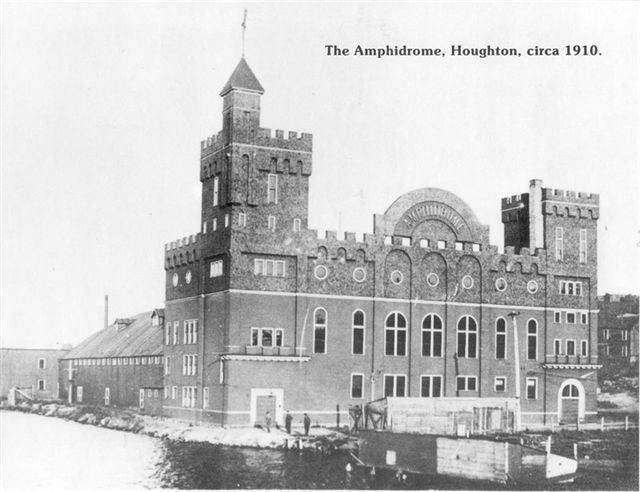
|

 Posts:
Posts: 9914
 Posted: Posted: Tue Mar 10, 2009 2:29 pm
The first organized hockey game took place on March 3, 1875 at the Victoria Skating Rink in Montreal, based on a set of rules proposed by a group of McGill University students. The game also features a few of those students. Although there are records of forms of hockey being played back as far as 1843. The game in Montreal was the first under the standardized and formal rules. It should be noted that the first organized hockey game ended in a brawl between the hockey players and the members of the skating club who wanted their ice back.The last quarter of the 19th century was a great period of social organization and saw the standardization of many sports. Hockey, as we know it, began in Montreal where J. G. A. Creighton, who went on to become a McGill law student, established a set of formal rules. The key innovation was the substitution of a square, wooden disk (puck), which offered the players far more control than they had over a ball. In 1877, the first organized team, the McGill University Hockey Club, was formed and the first national association, the Amateur Hockey Association of Canada, was formed in 1886. 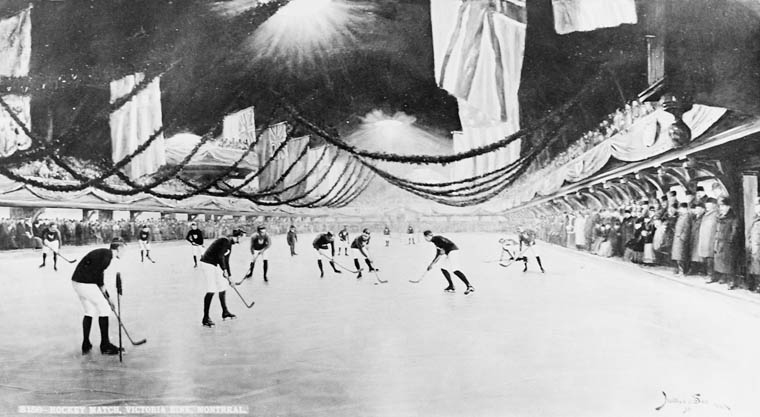
|

 Posts:
Posts: 9914
 Posted: Posted: Tue Mar 10, 2009 5:04 pm
Hockey Night in Canada is one of sports broadcasting's longest-running and most groundbreaking programs. The contractual foundation for the series was established on an Ontario golf course in 1929 with a handshake between Toronto Maple Leafs boss Conn Smythe and advertising agency owner Jack MacLaren. The agreement granted MacLaren and his General Motors client the radio rights to Leafs games once Maple Leaf Gardens had been built. The inaugural General Motors Hockey Broadcast subsequently aired on 12 November 1931, soon after the Gardens was completed, with Foster Hewitt calling a Leafs/Chicago Black Hawks match-up. That same night, a Montreal contest between the Canadiens and the New York Rangers was also transmitted. By the start of 1933, a 20-station hook-up relayed broadcasts in English from both Toronto and Montreal. A telephone survey estimated the combined per-game audience at just under a million-- in a country of less than ten million people; many of whom did not even own radio sets. A coast-to-coast ad hoc network for the program was in place by the end of the 1933-34 season. In 1936-37, Imperial Oil (another MacLaren client) replaced General Motors when GM of Canada's new president, freshly transferred from the United States, declared that he "did not believe hockey would sell cars." Meanwhile, on 1 January 1937, the Canadian Broadcasting Corporation (CBC) was launched as a public network and assumed national carriage of the program. Sometime thereafter, the series began to be identified as Hockey Night in Canada. HNIC's first publicly televised game originated from Montreal on 11 October 1952. The initial Toronto telecast followed on 1 November. The Toronto broadcasts were supervised by George Retzlaff, a 30-year-old technical director from Winnipeg who had just finished his CBC cameraman's training when he was named head of CBC Sports and producer of HNIC. Retzlaff's flair for cogent camera angles and sensitivity to the sound factors of a telecast proved to be vital assets in his new job. Meanwhile, Gerald Renaud, a 24-year-old newspaper sports editor from Ottawa, taught himself television and secured the job of Montreal sports producer. Renaud remarled, "The basic principle for the camera positions I wanted to have was an ideal seat from which to watch the game." HNIC broadcasts originally utilized three overhead cameras. In 1956, Renaud introduced a fourth "goal camera" at ice level to catch the action around one of the nets. This was a natural extension of his daring method for shooting a game and pioneered a tighter, more adventurous school of hockey directing. Toronto's Retzlaff was an innovator as well. Anticipating the video tape replay, he experimentally used a new "hot processor" in 1955-56 to develop a kinescope (film) recording of a goal within thirty seconds for "almost instant" replay. Separately, and in their own ways, Retzlaff and Renaud taught telecasters how to convey the hockey drama. In these early years, Retzlaff was also a master at keeping both the CBC and MacLaren Advertising happy; an essential factor in HNIC's fiscal stability. Throughout the 1950s, the national feed game alternated weekly between Toronto and Montreal with the opposite game downgraded to regional status for airing in Ontario or Quebec respectively. Because there was no real liaison between the two units, tensions and differences in coverage styles developed. In 1966 therefore, Ted Hough (whose MacLaren vice presidency made him administrative head of HNIC) hired TV football director Ralph Mellanby to be executive producer of all HNIC telecasts. To make the coverage more interesting, Mellanby began by requiring staff to ledger every stoppage in play and justify what the production featured during each stoppage. He introduced dramatic scripted openings to sell the personality of each particular game in the same way that teasers were used in entertainment series. Mellanby also brought in directional microphones to catch the sounds of crunching bodies and richocheting pucks and (once colorcasting began after a March, 1965 test) put the home team in white uniforms so that succeeding weeks' matches would benefit from the changing hues of different visitors' bright road jerseys.    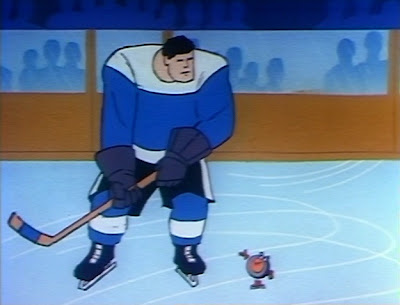
|

 Posts:
Posts: 9914
 Posted: Posted: Wed Mar 11, 2009 1:54 pm
The one-year countdown to the 2010 Winter Olympics in Vancouver has started. On February 28th 2010, the men's hockey gold medal game will be played, just 57 days short of 90 years after the Falcons won the first hockey gold medal in Antwerp. How the world and the Olympics have changed during those nine decades!       CANADA WINS OLYMPIC HOCKEY HONORS, OUTCLASSING SWEDEN Falcons Place Winnipeg Conspicuously on World Sporting Map, Overwhelming Swedes in Final 12 to 1 - Byron Drops in Surprise and Scandinavian Team Escapes a Whitewash. ANTWERP, April 26 (Associated Press) - Canada won the Olympic hockey championship tonight, easily defeating Sweden by a score of 12 to 1. Sweden's goal was scored in the first half, after ten minutes of play, and came as an utter surprise to the Canadians. The victors had easily scored five goals, when Sevensson, the Swedish right defence, carried the puck down near to the Canadian goal and drove it into the net, surprising Goalkeeper Byron so much that he fell down. The Canadian line-up was the same as in yesterday's game, with the exception of one position - Fridfinnson replacing Woodman. The score at the end of the first half was: Canada, 5; Sweden, 1. -------------------------------------------------------------------------------- This was the famous goal, the only one scored against the Falcons in the whole tournament. The Swedish team considered this goal a victory, putting them ahead of all the other European teams in the European hockey world. Did the Falcons momentarily lose their focus? Did Wally Byron accidentally let it in because the Swedes were such nice guys? We'll never know for sure.
|

 Posts:
Posts: 9914
 Posted: Posted: Thu Mar 12, 2009 7:14 pm
 The longest game ever played was in Montreal on March 24, 1936. It was game one of the semifinal round of the Stanley Cup Playoffs between Detroit and Montreal. It ended when Detroit's Mud Bruneteau scored the game's only goal in the sixth overtime period after 176 minutes and 30 seconds of game play.
|

 Posts:
Posts: 9914
 Posted: Posted: Fri Mar 13, 2009 2:25 pm
The NHA, the league that preceded the NHL, had it first season in 1910. There were seven teams that first season. The Cobalt Silver Kings, Haileybury Comets, Montreal Canadiens, Montreal Shamrocks, Montreal Wanderers, Ottawa Senators†, Renfrew Creamery Kings. By the 1914-15 season, the Stanley Cup was contested for by the league winners of the NHA and the PCHL based in Vancouver. The first year seeing the Vancouver Millionaires defeat the Ottawa Senators in a best of three series. The league trophy was the O'Brian Cup donated by the O'Brian family of Renfrew. 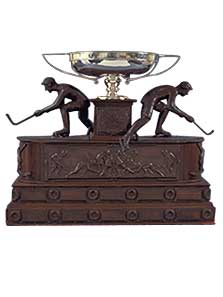 The 1916-17 season proved to be the last for the NHA. The Montreal Canadians won the championship that season defeating the Ottawa Senators. In 1918 the Montreal and Ottawa ownership established the NHL made up of only four teams in it's inaugural season. Montreal Canadians, Toronto Arenas, Ottawa Senators and the Montreal Wanderers. In it's last season, the NHA had a Toronto based team composed of professional hockey players in military. The Toronto 228th Battalion folded at the end of WWI. 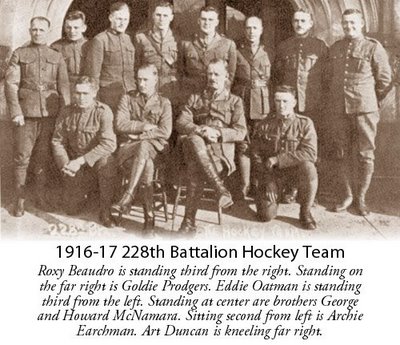
|

 Posts:
Posts: 9914
 Posted: Posted: Fri Mar 13, 2009 2:57 pm
All the Logo's used by Toronto's professional hockey teams. 
|

 Posts:
Posts: 9914
 Posted: Posted: Sun Mar 15, 2009 8:29 am
 Who was the first European trained player to play in the National Hockey League? Many of you probably said Borje Salming. While he was the first to stick and to star in the National Hockey League, another Swede had played in 5 NHL games nearly a decade earlier. His name was Ulf Sterner. Ulf Sterner was this super kid out of Sweden. Described as "a smooth skater, seamless passer and scorer with enormous offensive talent," he debuted internationally at the 1960 Olympics at the age of 18. He would lead Sweden to the 1962 World Championship gold medal and the 1963 World Championship silver medal. At the 1964 Olympic games in Innsbruck Sterner would lead all scorers with eleven points in seven games. One report suggests Sterner accepted a New York Rangers training camp invite as early as 1963. He supposedly played well enough to earn a 5-game tryout contract to play in NHL games that season. Because it was an Olympic season he was worried about altering his amateur status. He ended up going home to Sweden and did not play for the Rangers that year. Sterner definitely was with the Rangers for training camp in 1964 and was said to have wowed spectators in several exhibition games. The Rangers signed him to a contract under the agreement that he would start the year learning the rougher, North American game with the Ranger's Central League farm team in St. Paul. After 12 goals in 16 games he was bumped up to the Baltimore Clippers of the AHL. Centering the top line with Ken Schinkel and Ray Bruenl on the wings. He impressed with 18 goals and 44 points in 52 contests, but was heavily criticized for his lack of physical play. In those days, international rules prohibited any body checking in the offensive zone, which left Sterner completely unprepared for the North American game. Still happy with his skill game, the Rangers called up Sterner late in January, 1965. He would play in 4 NHL contests before returning to the minors. Unwilling to play the physical game necessary to stick in the NHL, Sterner returned to Sweden, secure in the knowledge that talent wise he was every bit as good as most Canadian players. He continued to play in Sweden and for the Swedish national team for another decade.
|

 Posts:
Posts: 9914
 Posted: Posted: Sun Mar 15, 2009 8:58 am
Article link..... http://www.losthockey.com/odds_jacobs_paul.cfmOnly a few grainy pictures survive of Paul Jacobs. Did Paul Jacobs beat Fred Saskamoose by more than 30 years to be the first native player? Fred Saskamoose of Saskatchewan is officially recognized as the first aboriginal hockey player to suit up for an NHL team, after he took to the ice for 11 games in 1954. A recent television documentary named They Call me Chief furthered this notion in it's recollection of his career and that of others who came after him. But there is a possibility that a Mohawk from Kahnawake, Quebec, named Paul Jacobs earned this distinction some 35 years earlier than Saskamoose. Paul Jacobs, who is considered one of the NHL's true Mystery Men, is a player who has kept his secrets for over 85 years. With a penchant for the obscure, Jacobs has interested me since the first time I read about him. Very little was known about the player, and a handful of hockey's leading historians were able to provide me with a few details, which, once paired with a little determination, has permitted me to shed a little more light on this elusive figure. Jacobs grew up in the Montreal / Lachine area, on the Kahnawake (Caughnawaga) Territory. His earliest known hockey stats are for the 1912-1913 season when he played for the Montreal Dominion Bridge hockey team. The following year he played for the St. Lawrence Bridge Hockey Team. Although these facts may appear as irrelevant at first glance, they offered a vital clue in this mystery. The 1916-17 season is the only one where hockey or Lacrosse statistics have yet to be uncovered for Jacobs. However, there was a major project underway in Toronto that year: The Bloor Street Viaduct, for which the construction contract had been awarded to none other that the Dominion Bridge Company. This may also explain why in the summer of 1918, the Leaside Braves (often called the Indians) Lacrosse Team in Toronto had a new player who was putting in a solid performance as a rough and agile goal scorer. Paul Jacobs tallied 6 goals in 5 games for the Indians, and often generated content for sports writers being described as "flashy" and "selfish". Paul's membership to the Leaside Lacrosse team was considered by some to be the reason that he was referred to as "The Indian" in newspaper reports, and did not necessarily reflect the fact that he was native. However, my visit to Kahnawake in the summer of 2003 laid to rest any doubt. Thanks to the help offered by the staff at the Kahnawake Cultural Centre, I was able to locate the photographs used in this article of Paul as well as a book on the history of Kahnawake. In the book, there is a section on locals who excelled in sports which explicitly mentions Jacob's hockey and Lacrosse skills. I also came across another "Skywalker" from Kahnawake in the same book named Joe Jocks, who allegedly played hockey for the New York Rovers while in the city working on the Empire State Building. Joe later moved to San Francisco to work on the Bay Bridge. The Big Leagues Paul's efforts on the field did not go unnoticed by the Ontario Lacrosse Association's president, Charlie Querrie. Charlie no doubt learned of Jacobs' previous hockey experience with teams in the Montreal City League as well as a stint with the New Haven Hockey Club of the USAHA. In the winter months, Querrie just happened to be the General Manager of the Toronto Arena NHL team, and he extended an invitation to Jacobs to attend training camp, which Jacobs accepted on December 10, 1918. Reports in the Toronto Telegram and the The Globe said Jacobs "Shows Good Form" and "...combined nicely with Noble and Denneny for several clever goals." at training camp. On the day before the season opener for the Arena team against the Montreal Canadiens, the Toronto papers printed the proposed team roster, and Jacobs had earned himself a spot alongside many who would become legends. On December 23, 1918, the Arenas lost their season opener by a score of 4 to 3. However, newspaper reports and game summaries the following day did not show Jacobs in the lineup. In fact, The Globe had a tiny mention in the "Puckerings" section of the sports page which read as follows: "Paul Jacobs, the Leaside Indians defence player, who has been trying out with the Toronto Arenas, will not be available this season. He is leaving for Montreal to-night and will reside in that city in future" So it would appear that Jacobs did not in fact play in an NHL game after all. Or did he? "The Blue and White Book" authored by Andrew Podnieks, which is a detailed account of the history of the Toronto Maple Leafs (which the Arenas would ultimately become), states that Jacobs actually played in five games for the Arenas that season throughout January and February. "Total Hockey 2", regarded as most as the hockey statistics bible, credits Jacobs with only the one game on December 23rd, 1918. No official league game reports are believed to exist for that season, and his inclusion was based on game summaries from newspapers. However, to date I have checked nine papers, both French and English from Toronto, Montreal and Ottawa. The only paper to include Jacobs in the lineup in the following day's game summary was the Ottawa Evening Journal. All other papers simply do not make any mention of Jacobs in the lineup, or his sudden exclusion for that matter. In an era before satellite connections and the Internet, the lineup was very likely wired to the paper in question a day or two before, and simply not corrected on the 24th. Furthermore, it is hard to believe that Jacobs could have played five games for the Arenas that season as he was playing for the Montreal Stars of the MCHL at the same time. Although no games he is credited with having played in Toronto in "The Blue and White Book" actually fell on the same nights which he was known to have been in the Stars lineup, several were back-to-back. Could he have been boarding a train and going from city to city? Logistics and economics however, make this very unlikely. Also, none of the game summaries in newspapers for any of the games show Jacobs in the lineup. Once again, Paul Jacobs disappeared from a lineup without explanation. For whatever reason, he did not finish the season with the Montreal Stars in early 1919. The following season he reappeared in the MCHL, this time with the Laval University team. In 1920-21, he apparently did not play, and after a brief 6 game stint in Quebec City, he emerged in Cleveland, Ohio in 1922 to play 16 games with the Indians of the USAHA. This was the most games he is known to have put in with a team in a single season. Could there have been a large bridge or high rise project there at the time? After one more season in Montreal, his last known season of hockey was again played in Cleveland in 1924-25 with the same team. That is the last trace of Paul Jacobs I am aware of. A trip through the Kahnawake Cemetery turned up many Jacobs', but none named Paul. I do not know either his dates of birth or death. Still More Questions So what became of Paul Jacobs? Did he actually make NHL history on the night of December 23rd, 1918, or does Fred Saskamoose deserve the distinction he has been credited with for almost 50 years? But wait! It gets more complicated. Hockey historian Don Andrews uncovered a clip from the Sudbury Star newspaper dated May 22, 1923, with the following headline: "North Bay gets Maracle. Much sought after Haileybury indian hockey star locates in railway town". It goes on to read: "Albert Maracle star Indian centre of Haileybury High School team, left this weekend for North Bay, where he will play ball this summer and hockey this winter." Maracle would later make it to the NHL for 11 games with the Rangers in 1931. Seems more research is required... These question will likely never be answered conclusively, but we do know that Paul Jacobs could have made history that night if he chose to or not.
|

 Posts:
Posts: 9914
 Posted: Posted: Sun Mar 15, 2009 9:03 am
 Fred Sasakamoose was born on the Big River Indian Reserve1 about 25 kilometres from his home reserve of Ahtahkakoop, on December 25, 1933. He started skating on bobskates at a young age on a slough, and when Fred was about 8 years old he attended St. Michael Residential School, in Duck Lake, Saskatchewan. It was at St. Michae1's that Fred received his hockey instruction and education . Fred was a member of the St. Michael Midget hockey team when they won the Provincial Championships in 1948-1949 against Regina. The following year, at age 16, Fred started a 4 year stretch with the Moose Jaw Canucks of the Western Hockey League, that would culminate with him winning the Most Valuable Player Award for the 1952-1953 Season. The same season Fred would jump from Junior Hockey to the National Hockey League for the remainder of the season. At the age of 19, Fred became the first Treaty Indian to play in N.H.L. when only 6 teams existed in the N.H.L. During the next few years, Fred played hockey in the N.H.L. Farm Teams with New Westminster, Calgary and Chicoutimi. He ended his Pro career with Kamloops Chiefs, but not before he was made Honourary Chief of the Kamloops Indian Reserve. Fred became involved in Indian Leadership, becoming a Band Councilor for Numerous years and eventually Chief for 6 years. His story became very popular with numerous articles and television mini series portraying his life. He began to develop Indian Hockey Schools for youth and established the Saskatchewan Indian Bantams that became a traveling team to Europe and other places, with the focus of displaying Indian talent. He became a builder of Indian Sports and Recreation and promoted youth participation for the purpose of providing activities for young aboriginal children. He currently enjoys the outdoors life of hunting, trapping, fishing, Farming and he now enjoys watching his grandchildren play hockey, and keeps his eye out for the next NHL'er.
|

 Posts:
Posts: 9914
 Posted: Posted: Sun Mar 15, 2009 8:06 pm
Bobby Orr... The highest scoring defenceman in NHL history. The goal most remembered of Bobby's....two views   Robert Gordon "Bobby" Orr is considered to be one of the greatest hockey players of all time. He played the majority of his National Hockey League (NHL) career with the Boston Bruins, with the exception of two brief seasons with the Chicago Black Hawks. Orr won two Stanley Cup championships with the Bruins in 1970 & 1972 and was awarded the Conn Smythe Trophy as the playoff MVP both years. Winning a record eight Norris Trophies as the league's best defenceman, Orr is often credited for revolutionizing his position. He remains the only defenceman to have won the league scoring title with two Art Ross Trophies and holds the record for most points and assists in a single-season by a defenceman. In his first professional season, he won the Calder Memorial Trophy as the league's most outstanding rookie. Late in the season, however, he missed nine games with a knee injury — presaging such woes through his career. While the perennially cellar-dwelling Bruins finished in last place that season, Orr sparked a renaissance that propelled the Bruins to make the playoffs the following twenty-nine straight seasons. New York Rangers defenceman Harry Howell, the winner of the Norris Trophy as the league's best defenceman in Orr's rookie year, famously predicted that he was glad to win when he did, because "Orr will own this trophy from now on."The only players in league history scoring more points per game than Orr are the following: Wayne Gretzky, Mario Lemieux and Mike Bossy.
Orr inspired the game of hockey with his command of the two-way game, which was unique for a defenceman. Defencemen with goal-scoring ability were not common in the NHL prior to his arrival. Orr was unique in that he could score goals as well, and he influenced countless defencemen who followed him. His speed, most notably a rapid acceleration, and his open ice artistry electrified fans as he set almost every conceivable record for a defenceman. In contrast to the style of hanging back defensive play common in the later 1950s and 1960s, Orr was known for his fluid skating and end-to-end rushing. Orr's rushing enabled him to be where the puck was, allowing him not only to score effectively but also defend when necessary. According to longtime Bruins' coach and general manager Harry Sinden, "Bobby became a star in the NHL about the time they played the National Anthem for his first game with us." Orr also benefited from playing most of his career in Boston Garden, which was nine feet shorter and two feet narrower than the standard NHL rink. This suited his rushing style very well, as he was able to get from one end of the ice to the other faster than in a standard rink. His style of play was also hard on his knees and shortened his career. "It was the way I played," Orr has said. "I liked to carry the puck and if you do that, you're going to get hit. I wish I'd played longer, but I don't regret it." Orr stated in 2008. "I had a style — when you play, you play all-out. I tried to do things. I didn't want to sit back. I wanted to be involved." 
|
 Posted: Posted: Sun Mar 15, 2009 8:23 pm
1919 Stanley Cup FinalThe 1919 Stanley Cup Finals ice hockey play-off series to determine the 1919 Stanley Cup champion ended with no champion decided, being suspended after five games had been played due to an outbreak of Spanish Influenza. This was the first and, as of 2009, only time since its donation in 1893 that the Stanley Cup was not awarded after the playoffs began. Hosting the series in Seattle was the the Pacific Coast Hockey Association (PCHA) champion Seattle Metropolitans (Mets) playing off against the National Hockey League (NHL) champion Montreal Canadiens. Both teams had won two games, lost two, and tied one before health officials were forced to cancel the deciding game of the series. The entire Canadiens team and its manager George Kennedy fell ill with the flu and were hospitalized. The flu would eventually claim the life of Canadiens' defenseman Joe Hall four days later. Kennedy was permanently weakened by his illness, and it led to his death a few years later. 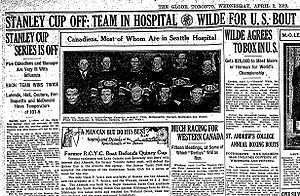
|

 Posts:
Posts: 9914
 Posted: Posted: Sun Mar 15, 2009 9:17 pm
St. Michael's College School is a private, all-boys Roman Catholic day school in Toronto, Canada. The school is perhaps best known as a producer of hockey players and football players. The St. Michael's College Hockey Team was first established in 1906 when the team joined the junior division of the Ontario Hockey Association. The team was not known as the St. Michael's Majors until 1934, and also had the informal nickname of the "Irish". The school team played for 55 years until 1961 before suspending operations. St. Michael's revived the Majors (Junior A Tier I) hockey team for the 1997-98 season in the Ontario Hockey League. In total, over one hundred St. Michael's Majors alumni have gone on to play in the National Hockey League, including 13 members of the Hockey Hall of Fame. Over 180 St. Michael's alumni have played in the National Hockey League, including Hockey Hall of Fame inductees Bobby Bauer, Gerry Cheevers, Red Kelly, Tim Horton, Dave Keon, Ted Lindsay, Frank Mahovlich, Reg Noble, and Joe Primeau. The standard of hockey exceeds others to a level that their Junior hockey team competes on the Senior Tier two stage. The school's flagship hockey team, the St. Michael's Majors, have won the Memorial Cup four times. The school also operates a team in a second level of junior hockey, Tier II Junior "A" known as the St. Michael's Buzzers. Those who know their player history will notice by the Hall of Fame inductees that St. Michael's was a hotbed of talent for the Toronto Maple Leafs up until 1961. 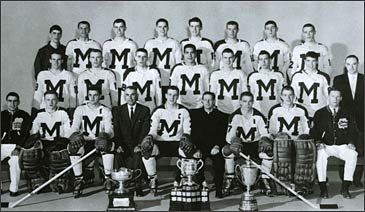
|
 
|
Page 2 of 4
|
[ 46 posts ] |
Who is online |
Users browsing this forum: No registered users and 1 guest |

|
|

